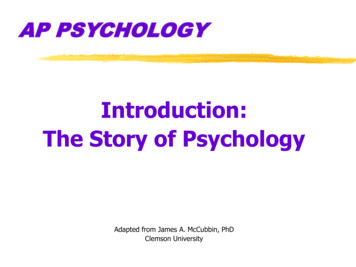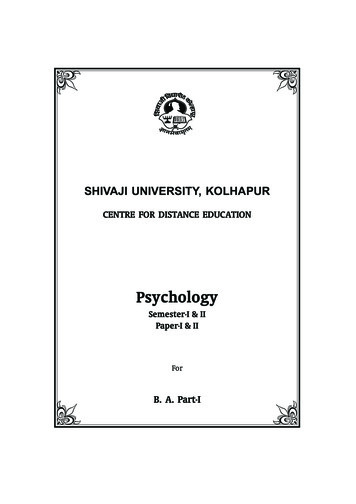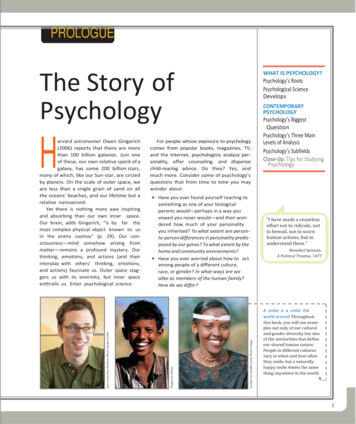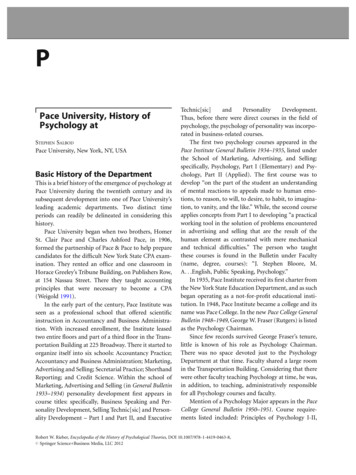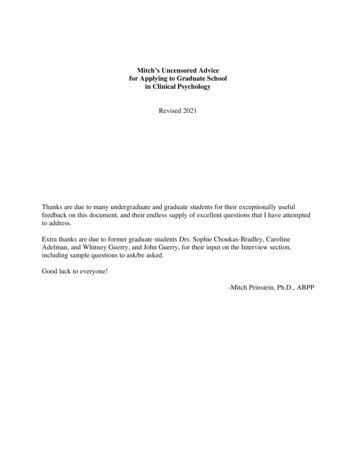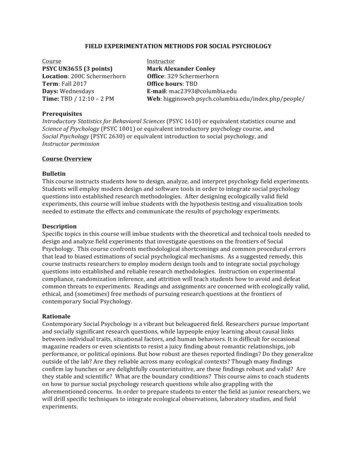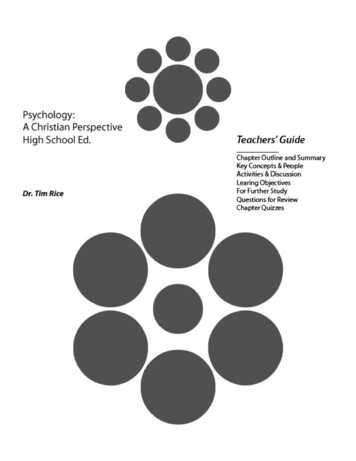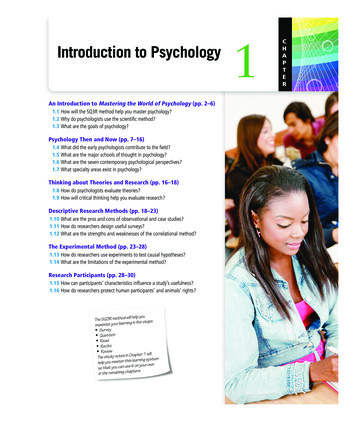
Transcription
Introduction to Psychology1CHAPTERAn Introduction to Mastering the World of Psychology (pp. 2–6)1.1 How will the SQ3R method help you master psychology?1.2 Why do psychologists use the scientific method?1.3 What are the goals of psychology?Psychology Then and Now (pp. 7–16)1.4 What did the early psychologists contribute to the field?1.5 What are the major schools of thought in psychology?1.6 What are the seven contemporary psychological perspectives?1.7 What specialty areas exist in psychology?Thinking about Theories and Research (pp. 16–18)1.8 How do psychologists evaluate theories?1.9 How will critical thinking help you evaluate research?Descriptive Research Methods (pp. 18–23)1.10 What are the pros and cons of observational and case studies?1.11 How do researchers design useful surveys?1.12 What are the strengths and weaknesses of the correlational method?The Experimental Method (pp. 23–28)1.13 How do researchers use experiments to test causal hypotheses?1.14 What are the limitations of the experimental method?Research Participants (pp. 28–30)1.15 How can participants’ characteristics influence a study’s usefulness?1.16 How do researchers protect human participants’ and animals’ rights?l help youThe SQ3R method wilin five steps:ngrnileauryomaximize Survey Question Read Recite Reviewapter 1 willThe sticky notes in Chrning systemleaistherhelp you maston your ownso that you can use itrs.tein the remaining chapM01 WOOD0532 01 SE C01.indd 11/31/13 1:14 PM
2Chapter 1 Introduction to PsychologyIN LINE ICONSIN LINE ICONST HINK A B O U T ITHere you are taking your first psychology course and wondering what it’s allabout. When you focus on the word psychology, what ideas spring to mind as youconcentrate? Do terms such as therapy, brain, psychological disorder, emotion,and hypnosis come to mind? Your introductory psychology course will touch onall of these concepts, but it will also help you learn how to deal with pressingpractical issues in your everyday life. How can you study more effectively? (Youcan start answering this one by reading the Apply it section on page 4.) Howcan you know which career is right for you? How can you solve conflicts andmaintain satisfying relationships with others? These are the kinds of practicalquestions that a good understanding of psychology can help you answer?Let’s begin your exploration of psychology with an assessment of howmuch you already know, or think you know, about the topic:Indicate whether each statement is true (T) or false (F).1. Once damaged, brain cells never work again.2. All people dream during a night of normal sleep.3. As the number of bystanders at an emergency increases, the time it takesfor the victim to get help decreases.IN MARGIN4.5.6.7.8.9.10.Humans do not have a maternal instinct.It’s impossible for human beings to hear a watch ticking 20 feet away.Eyewitness testimony is often unreliable.Chimpanzees have been taught to speak.Creativity and high intelligence do not necessarily go together.When it comes to close personal relationships, opposites attract.The majority of teenagers have good relationships with their parents.You may be surprised to learn that all the odd-numbered items are false,and all the even-numbered items are true. Learning all you can from this textis a good first step toward a better understanding of behavior and mentalprocesses. The text’s features will help you learn because they are part of asystematic—that is, a goal-oriented, planned, and effortful—way of studying.Similarly, the procedures that scientists use yield reliable answers to questionsabout behavior and mental processes because they are part of a systematicapproach to what some philosophers deem to be the primary goal of science:to search for truth (Popper, 1972).IN MARGINView on MyPsychLabView on MyPsychLabWatch theon MyPsychLabVideo Episode 1: Thinking Like aPsychologists DebunkingMyths onin MyPsychLabWatchListen on MyPsychLab.comAn Introduction to Masteringthe World of PsychologyListen on MyPsychLab.comExplore on MyPsychLabA Ugandan expression says, “The hunter in pursuit of an elephant does not stop tothrow stones at birds.” In other words,achieveany goal, including succeeding in aINtoLINEICONSpsychology course, one must remain focused on it. The study strategies we have incorporated into Mastering the World of Psychology can help you stay focused on yourMyPsychLabfollowing five steps: (1)Simulatesurvey, (2)onquestion,goal of successfully completing your course in introductory psychology. Here is how(3) read,(4) recite,and (5)onreview.Studyand ReviewMyPsychLabthe features of the text can help you.Study and Review on MyPsychLabExplore on MyPsychLabSimulateonMyPsychLabSQ3R method A study method involving theRead on MyPsychLab1.1 How will the logy?MyPsychLabMap on MyPsychLabStep 1: Surveyobjectives in the Read over the learningg of the chapter.outline at the beginninjor elements of Look over the other mae the following:ludthe chapter. They incopener Think About It chapters Key term Summarize It tables Try It activities Explain It boxes Apply It boxesary. Skim the Chapter Summyou’ll use asnetlioug Create note-takinr. Your outline willyou read the chaptes:include these elementas of the The titles and main idesionchapter’s secteach The learning questionsersswansectionactivity at the Do the Think About Itr.teapbeginning of the chStudying Psychology: Some Tricks of the TradeTo help you maximize your learning, Mastering the World of Psychology includes a setof tried and true study strategies—Survey, Question, Read, Recite, and Review—thatare collectively known as the SQ3R method (Robinson, 1970). Here’s how to make themost of the SQ3R features that we have included in Mastering the World of Psychology:step 1: Survey. The goal of the survey step is to get the chapter’s “big picture,” a mental map of what it’s all about. That’s the purpose of the list of learning questions at thebeginning of each chapter. The questions give you a blueprint to use as you navigatethrough the chapter and tell you what you will learn in each section. Use the learningquestions to create a note-taking outline that you will fill in as you read the chapter.Next, look over the major elements of the chapter. These elements include the chapteropening activity called Think About It, the section headings, Summarize It tables, TryIt activities, Explain It boxes, and Apply It boxes. You should also survey the learningquestions in the margins by each subheading (the same questions that are listed at thebeginning of the chapter) and the boldfaced terms that are also in the margins. Next,MARGINskim over the Chapter Summary. It INincludesanswers for all the learning questions.Next, do the Think About It activity at the beginning of the chapter, keeping in mindon MyPsychLabthe mental overview of the chapter that Viewyou constructedwith the help of the learningquestions. Now you’re ready to start working your way through the chapter.Watch on MyPsychLabListen on MyPsychLab.comExplore on MyPsychLabM01 WOOD0532 01 SE C01.indd 2Simulate on MyPsychLab1/31/13 1:14 PM
An Introduction to Mastering the World of Psychology 32: Question. Do the Question step as you come to each subheading in thechapter. This step has two parts: First, read the learning question in the margin. Forinstance, the learning question for this subsection is “How will the SQ3R methodhelp you master psychology?” Next, think of additional questions you have about thetopic and add them to the note-taking outline you created notes in the Survey step.stepstep 3: Read. Read the text under each subheading, keeping in mind the learningquestion and your own questions. Use the Apply It boxes, Try It activities, Explain Itboxes, and Summarize It tables, if any are present, to help you understand the section.4: Recite. When you finish reading each subsection, answer its learning q uestionand your own questions aloud in your own words. Jot your answers, along with briefdefinitions for the section’s key terms, in your outline. When you’re finished, lookback at the section to see if you’ve missed anything and modify your notes if necessary. Repeat this process for each subsection and you’ll end up with a well-organizedset of notes on the entire chapter.Step 2: Questionfor eachUse the question stepter. It hasapcheth subheading intwo parts:tion in the Read the learning quesmargin.estions you Think of additional qu.have about the topicstep5a: Review I. To be sure you’ve understood each major section before you moveon to the next one, answer the Remember It questions. You should find many of theanswers in your notes. If you don’t, you should probably go back and revise them.Next, log on to MyPsychLab and take the section’s Quick Review quiz. Researchshows that repeated testing is one of the most effective study strategies you can use(Karpicke, Butler, & Roediger, 2009).step5b: Review II. After you have worked your way through the all the major sections, you need to review the entire chapter to be sure that you’re ready to be testedon it. Begin by reading the Chapter Summary and comparing it to your notes. Reviseyour notes if necessary. Next, complete the Study Guide and check your answersagainst the key in the back of the book. Revisit your notes and restudy the parts of thechapter you scored the lowest on in the Study Guide. Finally, take the chapter PracticeTest in the back of the book or log on to MyPsychLab to take the online ChapterExam. Reread the parts of the chapter that relate to any questions that you miss, andbe sure that you understand where you went wrong. At this point, you should be feeling confident about your mastery of the chapter.Now that you know how to study this text effectively, let’s consider in more detailwhat impact the work of psychologists has on our everyday lives. Before we begin,think about all of the ways in which psychology—and the language of psychology—plays an integral role in our lives.stepIs Psychology a Science?Step 3: Readeach subheadingRead the text underrstand it beforedeunand be sure youone. As you read:you go on to the nexttion in mind. Keep the learning quesns in mind.tioes Keep your own quTry It activis,xeboIt Use the Applyand Summarizeties, Explain It boxes,esent, to helpIt tables, if any are prbsection.suethyou understandStep 4: Reciteg each section:When you finish readinestion and Answer the learning quud in youraloyour own questionsown words.ur outline. Add the answers to yoion to see if Look back at the sectg.hinyou’ve missed anytcessary.neifnetli Modify your oueach subsecforsesocprRepeat thiswitup h a welltion and you will ends on the entireteorganized set of nochapter.1.2 Why do psychologists usethe scientific method?Psychology is defined as the scientific study of behavior and mental processes. If youare like most people, you have made many observations about both and perhaps havedeveloped a few of your own theories to explain them. From television, radio, or theInternet, you probably also have had some exposure to “expert” opinions on behaviorand mental processes. In fact, those may be the very sources that led you astray on thequiz at the beginning of the chapter.Many people believe that a field is a science because of the nature of its body ofknowledge. Few people question whether physics, for example, is a true science. But ascience isn’t a science because of its subject matter. A field of study qualifies as a scienceif it uses the scientific method to acquire knowledge. The scientific method consistsof the orderly, systematic procedures that researchers follow as they identify a researchproblem, design a study to investigate the problem, collect and analyze data, draw conclusions, and communicate their findings. The knowledge gained is dependable becauseof the method used to obtain it. The scientific method includes the following steps:Step 1: Observe and theorizepsychology The scientific study of behaviorand mental processes.scientific method The orderly, systematic rocedures that researchers follow as theypidentify a research problem, design a study toinvestigate the problem, collect and analyzedata, draw conclusions, and communicate theirfindings.Step 2: Formulate a hypothesisM01 WOOD0532 01 SE C01.indd 31/31/13 1:14 PM
4IN LINE ICONSIN LINE ICONSChapter 1 Introduction to PsychologyAP P LY ITMore Tips for Effective StudyingDecades of research on learning and memory have uncovered a number of strategies that you can use, in addition to the SQ3R method, to make your study timemore efficient and effective. Establish a quiet place, free of distractions, where you do nothing else butstudy. You can condition yourself to associate this environment with studying,so that entering the room or area will be your cue to begin work. Schedule your study time. Research on memory has proven that spaced learning is more effective than massed practice (cramming). Instead of studying forfive hours straight, try five study sessions of one hour each. To be prepared for each class meeting, set specific goals for yourself eachweek and for individual study sessions. Your goals should be challenging butnot overwhelming. If the task for an individual study session is manageable,it will be easier to sit down and face it. Completing the task you have set foryourself will give you a sense of accomplishment. The more active a role you play in the learning process, the more you willremember. Spend some of your study time reciting rather than rereading thematerial. One effective method is to use index cards as flash cards. Write akey term or study question on the front of each card. On the back, list pertinent information from the text and class lectures. Use these cards to help youprepare for tests.IN LINE ICONSagain and again until it is firmly locked in memory. If you are subject to testanxiety, overlearning will help. Forgetting takes place most rapidly within the first 24 hours after you study.No matter how much you have studied for a test, always review shortly beforeyou take it. Refreshing your memory will raise your grade. Sleeping immediately after you study will help you retain more of what youhave learned. If you can’t study before you go to sleep, at least review whatyou studied earlier in the day. This is also a good time to go through yourindex cards. Test, retest, and test again! A great deal of research indicates that testing andretesting yourself over material you have read enhances your ability to recallit when you are tested. For this reason, use all of the self-testing tools wehave included in the text as well as those that are available on MyPsychLab.MARGINOnce you’ve mastered theseINstudystrategies, use them to improve your comINcourses.MARGINprehension and success in all of your Overlearning means studying beyond the point at which you can just barelyrecite the information you are trying to memorize. Review the informationView on MyPsychLabView on MyPsychLabWatch theon MyPsychLabVideo Episode 6: What’s in It forINMakingMARGINMe?It Stick onin MyPsychLabWatchListen on MyPsychLab.comViewListenon MyPsychLabon MyPsychLab.comExplore on MyPsychLabWatchon MyPsychLabExploreon MyPsychLabSimulate on MyPsychLabListenon MyPsychLab.comSimulateon MyPsychLabStep 3: Design a studyStep 4: Collect dataStep 5: Apply results to the hypothesisStudy and Review on MyPsychLabExploreon MyPsychLabStudyand Review on MyPsychLabRead on MyPsychLabSimulateRead ononMyPsychLabMyPsychLabMap on MyPsychLabStudyandonReviewon MyPsychLabMapMyPsychLabWe describe each of these steps in detail in the following section and Figure 1.1Read on MyPsychLabon page 5 will help you visualize the process.theory A general principle or set of principlesproposed to explain how a number of separatefacts are related.Map on MyPsychLab1: Observe and Theorize. The first step in the scientific method is an interactive one in which a researcher observes some phenomenon and theorizes, or develops a hunch, about what might have led to it. For instance, suppose a psychologistobserves students playing video games on a big-screen TV in a student lounge andnotices that the men tend to get higher scores than the women do. She might speculatethat this gender difference results from differences in the amount of time that menand women spend playing video games. In other words, her hunch is that, in general,men get higher scores on video games because they practice more than women do.Such hunches are often derived from a psychological theory, a general principle orset of principles proposed to explain how a number of separate facts are related. Inour example, the researcher’s hunch seems to be based on a theory that emphasizesthe role of experience in shaping behavior; that is, her theory proposes that the moreexperience people have doing something, the better they are at it.step2: Formulate a Hypothesis. Based on her hunch about the cause of gender differences in video game scores, the researcher next comes up with a hypothesis, aspecific prediction that can be tested empirically—that is, with data. Although theresearchers’ theory suggests many possible hypotheses, one, in particular, is key tostephypothesis A testable prediction about theconditions under which a particular behavior ormental process may occur.M01 WOOD0532 01 SE C01.indd 41/31/13 1:14 PM
An Introduction to Mastering the World of Psychology 5Results failto supporthypothesisObserveFormulate atestablehypothesisDesigna studyTheorizeModifyhypothesisand sisReplicateFigure 1.1 The Scientific MethodThese are the steps involved in the scientific method.understanding the contribution of practice to video game scores: If males and femalesspend equal amounts of time practicing a game, their scores will be equal.3: Design a Study. Next, to test the hypothesis about equal practice, theresearcher could design a study in which she uses the same procedures to teach maleand female students how to play a new video game. Then she allows them 30 minutesto practice it on their own. At the end of the practice session, she tells participants toplay the game one more time but to try for the highest score possible.stepstep 4: Collect Data. Once the researcher conducts her study, she collects data thatare relevant to her hypothesis. First, she calculates an average score for male andfemale participants. Then she calculates the amount of time that participants actually spent practicing the game. This information could be critical in interpreting thestudy’s results because, even though each participant is allowed 30 minutes to practice, the researcher cannot assume that they will all practice an equal amount of time.5: Apply Results to the Hypothesis. If the scores for males and females are equivalent, the researcher can conclude that the data support her hypothesis. That is, giventhe same amount of practice time, males and females will score equally well. Next, theresearcher will make other psychologists aware of her findings by presenting them ata professional meeting, such as the annual convention of the American PsychologicalAssociation, or by publishing them in a professional journal. Such journals publishthe results of studies that have been reviewed by other researchers and found to bemethodologically sound, a process called peer review.However, publication is only one facet of the final step of the scientific. Theother is a process called replication in which the researcher or another psychologist who is intrigued by her findings or wants to challenge them to repeat the studyusing the same procedures. The purpose of replication is to determine whetherthe original results were a one-time phenomenon or evidence of a true, underlyingpsychological principle.On the other hand, if the researcher finds that males still get higher scores thanfemales, she must concede that the results do not support her hypothesis and she mustmodify it. However, this is where the researcher’s data on actual practice time maycome in handy: If the data show that males spent more time engaged in actual practicestepM01 WOOD0532 01 SE C01.indd 5replication The process of repeating a study toverify research findings.1/31/13 1:14 PM
6Chapter 1 Introduction to Psychologythan the females did, the researcher can assert that the study’s outcome supports herhypothesis after all. Still, she must modify her hypothesis to include a testable assertion about why the men in her study chose to practice more than the women did. Ifshe hypothesizes that the practice difference was caused by the type of game used inthe study, for example, in a subsequent study, the researcher would go on to examinehow different types of games affect practice time.1.3 What are the goals ofpsychology?The Goals of PsychologyWhat goals do psychological researchers pursue when they plan and conduct theirstudies? Briefly put, psychologists pursue four broad goals:Description: Identifying and classifying behaviors and mental processes asaccurately as possibleExplanation: Proposing reasons for behaviors and mental processesPrediction: Offering predictions (or hypotheses) about how a given condition or setIN LINEof conditionswillICONSaffect behaviors and mental processesIN LINE ICONSInfluence: Using the results of research to solve practical problems that involvebehavior and mental processesbasic research Research conducted to seeknew knowledge and to explore and advancegeneral scientific understanding.applied research Research conductedspecifically to solve practical problems andimprove the quality of life.Step 5a: Review Irstood each majorTo be sure you’ve undeve on to the nextsection before you moone:your outline for Look over the notes inbheadings.su’sioneach of the sectIt questions Answer the Rememberctionat the end of each seand take theabhLycPsMytoon Logquiz.wvieResection’s QuickTwo types of research help psychologists accomplish the four goals just described:basic research and applied research. The purpose of basic research is to seek newknowledge and to explore and advance general scientific understanding. Basicresearch explores such topics as the nature of memory, brain function, motivation,and emotional expression. Applied research is conducted specifically for the purpose of solving practical problems and improving the quality of life. Applied researchfocuses on finding methods to improve memory or increase motivation, therapies totreat psychological disorders, ways to decrease stress, and so on. This type of researchis primarily concerned with the fourth goal of psychology—influence—because itspecifies ways and means of changing behavior.The scientific method has enabled psychologists to accumulate a vast knowledge base about behavior and mental processes. However, information alone doesn’tnecessarily advance our understanding of psychological phenomena. As we notedearlier, using knowledge acquired through the scientific method to develop cohesivetheories can help us in the quest for understanding. With that point in mind, we’llturn our attention to some early attempts at psychological theory building and theschools of thought and psychological perspectives that arose from the debate stimulated by them.IN MARGINThe SummarizeIt below summarizes the goals of psychology and applies them toIN MARGINthe video game hypothesiswe discussed earlier.SUMMARIZE ITView on MyPsychLabView on MyPsychLabThe Goals of PsychologyWatch theon MyPsychLabVideo Episode 1: The Big Picture:Asking Tough Questionsin MyPsychLabWatch onListen on MyPsychLab.comEXAMPLEListen on MyPsychLab.comGOALDEFINITIONDescriptionDescribe behavior or mental process as accurately asCalculate average video game scores for males and females.Explore on MyPsychLabpossible.ExplanationSimulate on MyPsychLabSuggest causes for behavior or mental processes of interest.Propose that males score higher on video games becausethey practice more than females do.Study and Review on MyPsychLabPredictionSpecify conditions under which behavior orReadmentalonprocessMyPsychLab Hypothesize that males and females will obtain equivalentis likely to occur.video game scores if they practice the same amount of time.Read on MyPsychLabInfluenceon MyPsychLabApply the results of a study to change a Mapconditionin orderUse the results of video game practice studies to developMapanon MyPsychLabto bring about a desired real-world outcome or preventgames that can enhance females’ achievement in math andundesired real-world outcome.science.Explore on MyPsychLabSimulate on MyPsychLabStudy and Review on MyPsychLabRYM01 WOOD0532 01 SE C01.indd 61/31/13 1:14 PM
View on MyPsychLabWatch on MyPsychLabListen on MyPsychLab.comExplore on MyPsychLabPsychology Then and Now7Simulate on MyPsychLabREMEMBER ITCheck your answers and take additional quizzes in MyPsychLab.com.Study and Review on MyPsychLabReadon MyPsychLab1. The orderly, systematic procedures scientists follow in acquiring a body of knowledgecomprisethe .Map on MyPsychLab2. is the process of repeating a study to determine whether the results werereliable.3. The four goals of psychology are , ,, and .4. Applied research addresses the goal.Psychology Then and NowIf you were to trace the development of psychology from the beginning, you wouldneed to start before the earliest pages of recorded history, beyond even the early Greekphilosophers, such as Aristotle and Plato. Psychology became distinct from philosophy when researchers began to use the scientific method to study behavior and mentalprocesses. By the 1920s, the field’s earliest researchers had laid the foundations ofthe major schools of thought and psychological perspectives that exist in psychologytoday. As the field grew and research findings accumulated, specialty areas within thefield began to follow distinctive pathways.1.4 What did the earlyExploring Psychology’s RootsPsychology became a science and an academic discipline in the 19th century whenpeople who wanted to learn more about behavior and mental processes began to usethe scientific method. Conventional thought at the time held that such endeavors werethe exclusive province of white males. Nevertheless, several researchers overcame gender and ethnic prejudice in the late 19th and early 20th centuries to make notablecontributions to the field of psychology.psychologists contributeto the field?Structuralism and Functionalism. Who were the“founders” of psychology? Historians acknowledge thatthree German scientists—Ernst Weber, Gustav Fechner,and Hermann von Helmholtz—were the first to systematically study behavior and mental processes. But it isWilhelm Wundt (1832–1920) who is generally thought ofas the “father” of psychology. Wundt’s vision for the newdiscipline included studies of social and cultural influenceson human thought (Benjafield, 1996).Wundt established a psychological laboratory at theUniversity of Leipzig in Germany in 1879, an event considered to mark the birth of psychology as a formal academicdiscipline. Using a method called introspection, Wundtand his associates studied the perception of a variety ofvisual, tactile, and auditory stimuli, including the rhythmpatterns produced by metronomes set at different speeds.(A metronome is a mechanical or electronic device thatemits ticking sounds that represent musical rhythms suchas 2/4 and 4/4 time at varying tempos.) Introspection asa research method involves looking inward to examineone’s own conscious experience and then reportingthat experience.M01 WOOD0532 01 SE C01.indd 7 Even though these skydivers share the same sensations—the feelingof falling, the rush of air on their faces as they fall, and the sudden lurchof their parachutes opening—their reported introspections of theexperience would probably differ.1/31/13 1:14 PM
8 Chapter 1Introduction to Psychologystructuralism The first formal schoolof thought in psychology, aimed at analyzingthe basic elements, or structure, of consciousmental experience.functionalism An early school of psychologythat was concerned with how humans and animals use mental processes in adapting totheir environment.Wundt’s most famous student, Englishman Edward Bradford Titchener (1867–1927), took the new field to the United States, where he set up a psychological laboratory at Cornell University. He gave the name structuralism to this first formal schoolof thought in psychology, which aimed at analyzing the basic elements, or the structure, of conscious mental experience. Like Wundt before him, Titchener thought thatconsciousness could be reduced to its basic elements, just as water (H2O) can be broken down into its constituent elements—hydrogen (H) and oxygen (O). For Wundt,pure sensations—such as sweetness, coldness, or redness—were the basic elements ofconsciousness. And these pure sensations, he believed, combined to form perceptions.The work of both Wundt and Titchener was criticized for its primary method,introspection. Introspection is not objective, even though it involves observation,measurement, and experimentation. When different introspectionists were exposed tothe same stimulus, such as the click of a metronome, they frequently reported different experiences. Therefore, structuralism was not in favor for long. Later schools ofthought in psychology were established, partly as a reaction against structuralism,which did not survive after the death of its most ardent spokesperson, Titchener.Nevertheless, the structuralists were responsible for establishing psychology as a science through their insistence that psychological processes could be measured andstudied using methods similar to those employed by scientists in other fields.As structuralism began losing its influence in the United States in the early20th century, a n
An Introduction to Mastering the World of Psychology (pp. 2 – 6 ) 1.1 How will the SQ3R method help you master psychology? 1.2 Why do psychologists use the scientific method? 1.3 What are the goals of psychology? Psychology Then and Now (pp. 7 – 16 ) 1.4 What did the early psychologists contribute to the field? 1.5 What are the



